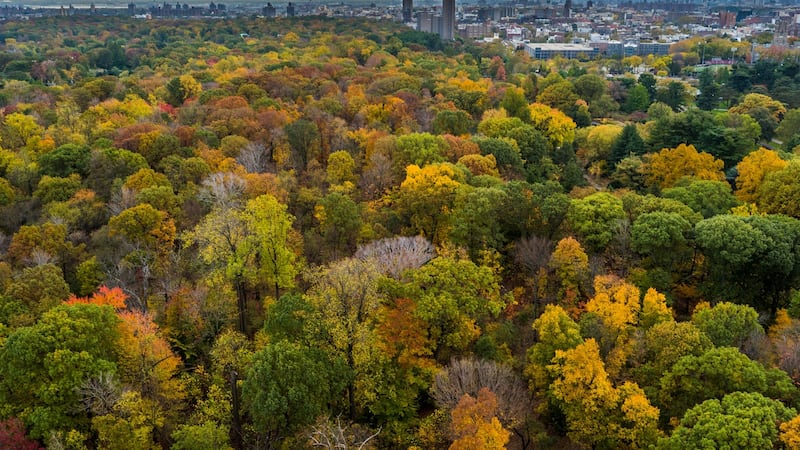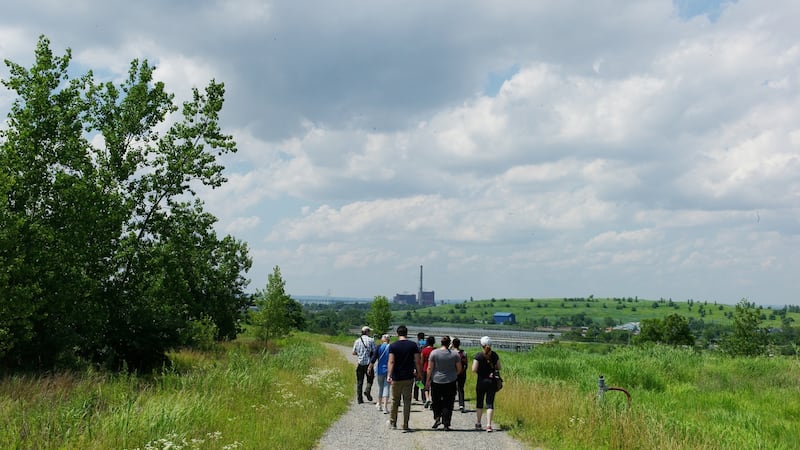Lou Reed's quintessential 1970s hymn to New York nightlife, Walk on the Wild Side, is limited to the strange behaviour of the human animal. Over recent decades, however, New Yorkers have become increasingly aware of another wild side to their city: the vast diversity of plants and animals that share Manhattan with a dense population of millions of people.
True, many species have disappeared since the Lenape people were the only human inhabitants of the place they called Manahatta, “the island of many hills”. Yet today, red-tailed hawks have returned to nest on skyscrapers, and you shouldn’t be too surprised if you spot a skunk on a sidewalk.
So much so that the city government has established a wildlife department. It is running an advertising campaign advising citizens that animals, “like other New Yorkers, know where to get a meal”. They don’t need any well-intentioned, but potentially lethal, snacks from passersby.
But these animals do need habitat, and that leads us to another surprising reality about the city: it still holds a significant amount of green space, which provides wonderful refuges for humans too, when you get weary of wandering its steel and glass canyons.
The birds of Central Park
Central Park is the best-known of these sanctuaries, and the naturalistic design produced by Frederick Law Olmsted and Calvert Vaux in 1858 has become a reference for urban parks across the world. What is not so well known, outside ornithological circles, is that this is one of the most important staging posts for small migratory birds, like sparrows, finches and warblers, in all North America.
The park's wide variety of woodland, meadow, rocky and watery habitats is soothing to the frazzled human spirit. It also provides a wide range of niches for many species seeking food and rest on their long journey down the western Atlantic flyway, from Canada to Cuba, Mexico and beyond.
Keen birders can find as many as 100 species here on a single autumn day. The Ramble, a maze of woodland walks above the Loeb Boathouse, where you can pause for coffee, a drink or a meal, is one of the best places to look for birds.
You can easily see many birds close-up that you wouldn't see at home, like the American robin, a fat dark thrush with a warm orange breast, and the male cardinal, finch-sized and decked out in Vatican red.
You'll see squirrels everywhere, the same American grey that has colonized Ireland, but here it is sometimes a startling black. Woodpeckers are quite common, and if you are lucky you might find a roosting owl.
There are many duck on the parks' plentiful ponds and lakes. And, if you keep your eyes on the sky, you may well see the spectacular red-tailed hawks, whose return to the park sparked a best-selling avian romance novel, Red-Tails in Love. More details here
Thain Family Forest
Visiting the Thain Family Forest in New York Botanical Garden requires a little more planning from downtown Manhattan than Central Park, but it’s only a 20-minute train ride on the Harlem line from Grand Central Station.
There is plenty to detain you in the formal gardens (admission $20) as you walk to the forest from the station, including a magnificent classic glasshouse of tropical and desert plants – and a very good cafe and bookstore.
But the garden would not have been located here were it not for the forest. These woods are an exceptional natural resource, set in a large gorge on either side of the Bronx river. They have never been either logged or commercially planted. It's about as close to old-growth forest as you can find in the State.

Other remnant patches of ancient forest in the city were stripped bare for fuel during the hard years of the Revolutionary War. But the Thain forest was saved, ironically enough, because rebels and British troops dug in for the duration on either side of the gorge. Anyone trying to get firewood would get shot at by both sides. Then a local milling family preserved it in fairly pristine condition until the garden was set up in 1895.
But today the forest is, inevitably, impacted by the global spread of invasive alien plants and insects. A grove of hemlock, a majestic conifer, was once the core of the forest, now it is struggling to survive new insect pests. The garden has implemented an extensive restoration programme to protect the original forest system as much as possible.
Happily, it remains a magical place to wander or, if you feel more adventurous, you can enjoy it by canoe as you shoot down the gorge. More details here
Fort Tryon Park
Another park can also offer a remarkable flavour of what this region might have been like before European settlement. Curiously, it also offers an opportunity to enjoy the tranquillity of medieval European cloisters, and the beauty of medieval European art.
There are parts of Fort Tryon Park, from great rocks that tower above the upper Hudson river, where you can look across to wooded bluffs on the other bank without a single obvious reminder of modernity. If there is no traffic on the river, and often there isn’t, you are seeing a view that probably differs little from what a Native American would have seen five centuries ago.
This park is again easily accessible, taking the subway's A train to 190th Street, about a half hour from midtown. Exits lead straight into the park, designed in the 1930s by the sons of Central Park's Frederick Law Olmsted. The first building you encounter will be their New Leaf Restaurant, now highly rated after restoration on the initiative of Bette Midler.
Other highlights include the Heather Gardens, three acres of world-class year-round horticulture, plus about 10km of walking and running trails, and many patches of semi-natural woodland, where you can find much of the wildlife typical of Central Park.
The park's jewel, however, has to be the Cloisters, an often-neglected outlier of the Metropolitan Museum. Its rich collection includes four entire cloisters, transplanted from Europe, a number of tender Madonnas that melted this agnostic's heart, and a large hall of marvellously fantastical unicorn tapestries. More details here and here.
The High Line
Back in Midtown, the High Line is one of the city’s youngest, most original, and most celebrated parks. It was born when locals began to notice that an abandoned elevated train track, running between 34th street/11th Avenue and 12th street, was being rapidly colonised by a wide range of grasses, wild flowers and trees.

They enjoyed walking this accidental green space, and began to campaign for its preservation as a “linear park” in 1999. In 2014, the last of three sections was opened to the public, forming a 5km route with unparalleled perspectives on the Hudson river, and delightfully intimate views of dozens of streetscapes from above.
The vegetation in some sectors retains an attractively wild and accidental appearance, with crab apples, sedges, asters and goldenrod dominating. As you go further south, there are a number of very diverse semi-formal gardens, some cleverly exploiting the features of the old rail tracks, others making them almost invisible.
There are hundreds of benches where you can relax and watch New Yorkers at work and play, or enjoy the many artworks (of varying quality), some permanent, some temporary, designed for the park. As well as proliferating new eateries, entire apartment blocks have sprung alongside the High Line, exploiting its great popularity. It has also inspired several similar projects abroad, including Dublin's LifeLine, which proposes a greenway from the National Botanic Gardens to the Liffey. More details here.
Brooklyn Bridge Park
The five boroughs of New York City have more attractive outdoor spaces than could be listed in a single article, but several others deserve mention.
Brooklyn Bridge Park has many remarkable features, but perhaps the best bit comes before the park itself: a walk along its dramatic approach road over the great bridge. It is one of the city’s iconic experiences, much less familiar, but as definitive as the view from the Empire State Building.
You stroll across the broad East River, starting across the road from City Hall at the southern end of Manhattan, and walk directly above the railway line, and with cars on highways below, on either side, shooting past.
Not even the presence of other walkers and cyclists can dispel the sense that this entire hike is a daring and delicious act of trespass, as you ascend steadily under the bridge’s massive pillars and huge steel cables stretching up into the sky. This breath-taking walk opens up expansive vistas towards Manhattan Bridge upriver, and Governor’s Island downstream, where the East River joins the Hudson, before you start your descent back to terra firma in the park on the Brooklyn side.
To explore the many options on arrival, from gardens to birding to roller-skating, see brooklynbridgepark.org.

Hunger Memorial
Perhaps it’s a stretch to call the Hunger Memorial a park, but this small hankerchief space, though apparently dwarfed by the new World Trade Center across the street, nonetheless manages to draw visitors into an intense experience of another place and time.
The idea of transporting a little piece of Ireland to New York to commemorate the famine could so easily have been sentimental, but this simple combination of a furrowed potato field and a ruined cottage is very powerful. It is saved from insularity by a remarkable series of quotes as you enter, that link the Irish experience to the shameful persistence of mass hunger in our world today. More details here.
Freshkills Park
The strangely named Freshkills is New York's most ambitious park project in more than a century, three times the size of Central Park. Its success will depend on the radical transformation of a notorious Staten Island landfill dump through a complex ecological restoration project, which promises to "recycle the land and reveal the future". It will not be fully open to the public until 2036, but you can already take birding, kayaking and horseriding tours from time to time. More details here.



















